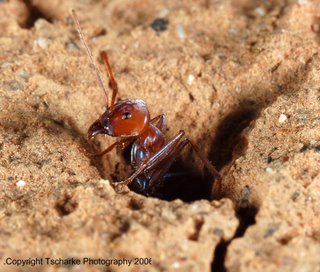 Rather than give away what this is from, ill leave it to your imagination. Comments always appreciated.
Rather than give away what this is from, ill leave it to your imagination. Comments always appreciated.
Friday, September 15, 2006
Chestnut and Gold
 Rather than give away what this is from, ill leave it to your imagination. Comments always appreciated.
Rather than give away what this is from, ill leave it to your imagination. Comments always appreciated.
Tuesday, September 12, 2006
Sienna Sky
Monday, September 11, 2006
Squama
Marsupial?
 Often mistaken for the introduced field mouse, the Fat-Tailed Dunnart is not a mouse at all! Like the kangaroo, this critter is actually a marsupial, and carries its young around in a pouch. This species is under threat mostly from its habitat (native grasslands) being destroyed for housing or farmland.
Often mistaken for the introduced field mouse, the Fat-Tailed Dunnart is not a mouse at all! Like the kangaroo, this critter is actually a marsupial, and carries its young around in a pouch. This species is under threat mostly from its habitat (native grasslands) being destroyed for housing or farmland.
Elusive
Thursday, September 07, 2006
Amoena
 This Charming Spider Orchid is one of only a handful of this species left in the world. Standing at 3 inches tall, it could easily be overlooked or trod on. This flower opened up on my birthday and only remained for 1 day before wilting. Considerable efforts are being undertaken by government agencies to keep this species viable, that we don't loose it forever.
This Charming Spider Orchid is one of only a handful of this species left in the world. Standing at 3 inches tall, it could easily be overlooked or trod on. This flower opened up on my birthday and only remained for 1 day before wilting. Considerable efforts are being undertaken by government agencies to keep this species viable, that we don't loose it forever.
Forward March!
 Meat Ants live in Massive colonies in drier soils of Australia. Nests can exceed 2 metres in diameter. The fun thing about taking photographs of these guys is that each nest has dozens of entrance holes, so while your waiting at one hole, thousands of ants come out of the others and cover you from head to toe!
Meat Ants live in Massive colonies in drier soils of Australia. Nests can exceed 2 metres in diameter. The fun thing about taking photographs of these guys is that each nest has dozens of entrance holes, so while your waiting at one hole, thousands of ants come out of the others and cover you from head to toe!
Maroon
Subscribe to:
Posts (Atom)



